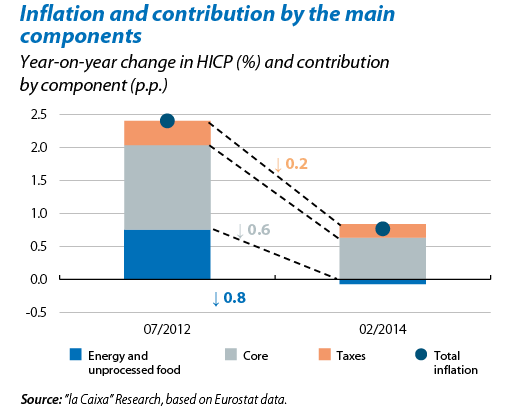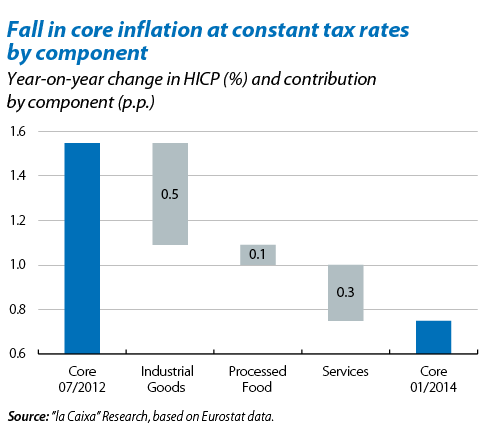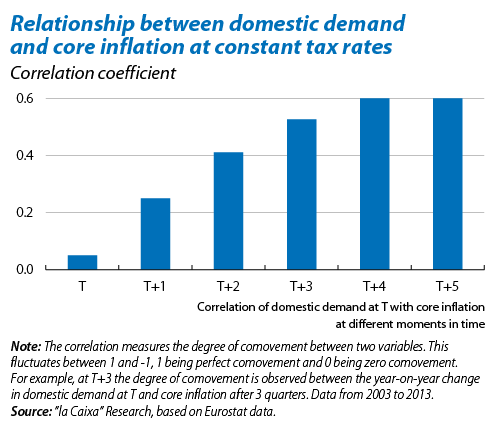
In the first graph we can see that the inflation rate fell by 1.6 p.p. from mid-2012 to January 2014. A drop of this size had not occurred since 2008, when the financial crisis was at its peak. A significant part of this fall is due to factors that can be interpreted as temporary. Energy prices, a factor that is quite volatile but which has traditionally pushed up inflation, have remained relatively stable over the last year and their contribution to the rise in the CPI has therefore diminished considerably. The weakening of the base effect caused by tax hikes in several euro area countries has also helped to bring down the rate of growth in the general price index. What is surprising, however, is the sharp fall in core inflation at constant tax rates as this has historically been more stable and its movements have reflected the underlying trends in economic activity. 40% of the slowdown in inflation is due to the drop in core inflation at constant tax rates.

60% of this contraction in core inflation at constant tax rates can be explained by the fall in the inflation rate for prices of non-energy industrial goods. Together with the price of services, these are a good reflection of the trend in domestic demand. One example of this is that, in periphery countries, where domestic demand has shrunk the most, we can also see a larger reduction in core inflation at constant tax rates. It is important to note, however, that the core inflation rate has historically delayed its reaction to changes in domestic demand. As can be observed in the third graph, the year-on-year change in domestic demand is associated with the core inflation rate seen after a few quarters. We therefore expect core inflation to halt its downward slide over the coming months as the recovery in domestic demand gradually takes hold. However, given that the recovery is not expected to be very vigorous, inflation will probably remain at abnormally low levels for a relatively long period of time. Although the risk of deflation is contained, prolonged low inflation should also make the ECB react.

Recommended Content
Editors’ Picks
EUR/USD clings to gains above 1.0750 after US data

EUR/USD manages to hold in positive territory above 1.0750 despite retreating from the fresh multi-week high it set above 1.0800 earlier in the day. The US Dollar struggles to find demand following the weaker-than-expected NFP data.
GBP/USD declines below 1.2550 following NFP-inspired upsurge

GBP/USD struggles to preserve its bullish momentum and trades below 1.2550 in the American session. Earlier in the day, the disappointing April jobs report from the US triggered a USD selloff and allowed the pair to reach multi-week highs above 1.2600.
Gold struggles to hold above $2,300 despite falling US yields

Gold stays on the back foot below $2,300 in the American session on Friday. The benchmark 10-year US Treasury bond yield stays in negative territory below 4.6% after weak US data but the improving risk mood doesn't allow XAU/USD to gain traction.
Bitcoin Weekly Forecast: Should you buy BTC here? Premium

Bitcoin (BTC) price shows signs of a potential reversal but lacks confirmation, which has divided the investor community into two – those who are buying the dips and those who are expecting a further correction.
Week ahead – BoE and RBA decisions headline a calm week

Bank of England meets on Thursday, unlikely to signal rate cuts. Reserve Bank of Australia could maintain a higher-for-longer stance. Elsewhere, Bank of Japan releases summary of opinions.